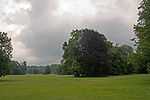Łęknica
| Łęknica | |||
|---|---|---|---|
 | |||
| |||
 Łęknica | |||
| Coordinates: 51°32′18″N 14°44′21″E / 51.53833°N 14.73917°E | |||
| Country |
| ||
| Voivodeship | Lubusz | ||
| County | Żary | ||
| Gmina | Łęknica (urban gmina) | ||
| Area | |||
| • Total | 16.4 km2 (6.3 sq mi) | ||
| Population (2006) | |||
| • Total | 2,641 | ||
| • Density | 160/km2 (420/sq mi) | ||
| Postal code | 68-208 | ||
| Website | http://www.leknica.pl | ||
Łęknica [wɛŋkˈɲit͡sa] (German: Lugknitz; Upper Sorbian: Wjeska) is a town in Poland, in Lubusz Voivodeship, in Żary County. It lies on the Lusatian Neisse, which forms the border between Poland and Germany, directly opposite the German town Bad Muskau. Its population numbers 2,648 (2004).
History
It was awarded city rights in 1452 (as a part of Bad Muskau). In 1880 Lugknitz was still a small Sorbian agricultural village, one of only two Sorbian speaking places east of Neisse (the other being Brunojcy). That changed with the turn of century, when industry was established on the Neisse. Brown coal started to be mined. Based on rich clay deposits, ceramic companies emerged and also glass factories. During the WW2 70% of the city was destroyed, as well as much of the industry (brown coal mine "Babina" from 40%, glassworks 30% and slate factories 50%). The town was separated from Bad Muskau by the new state border and gradually settled with military veterans, refugees, people returning from forced labour, people repatriated from France, Belgium and in 1958 18 families repatriated from the USSR settled in the city.
The town changed name several times, Łuknica in 1945–1947, then Ługnica and Łęknice. It received the name Łęknica in 1956.
Mużakowski Park
See also
- Muskau Park (aka Park Mużakowski)
External links
| Wikimedia Commons has media related to Łęknica. |
Coordinates: 51°32′N 14°46′E / 51.533°N 14.767°E
| |||||||||||||







